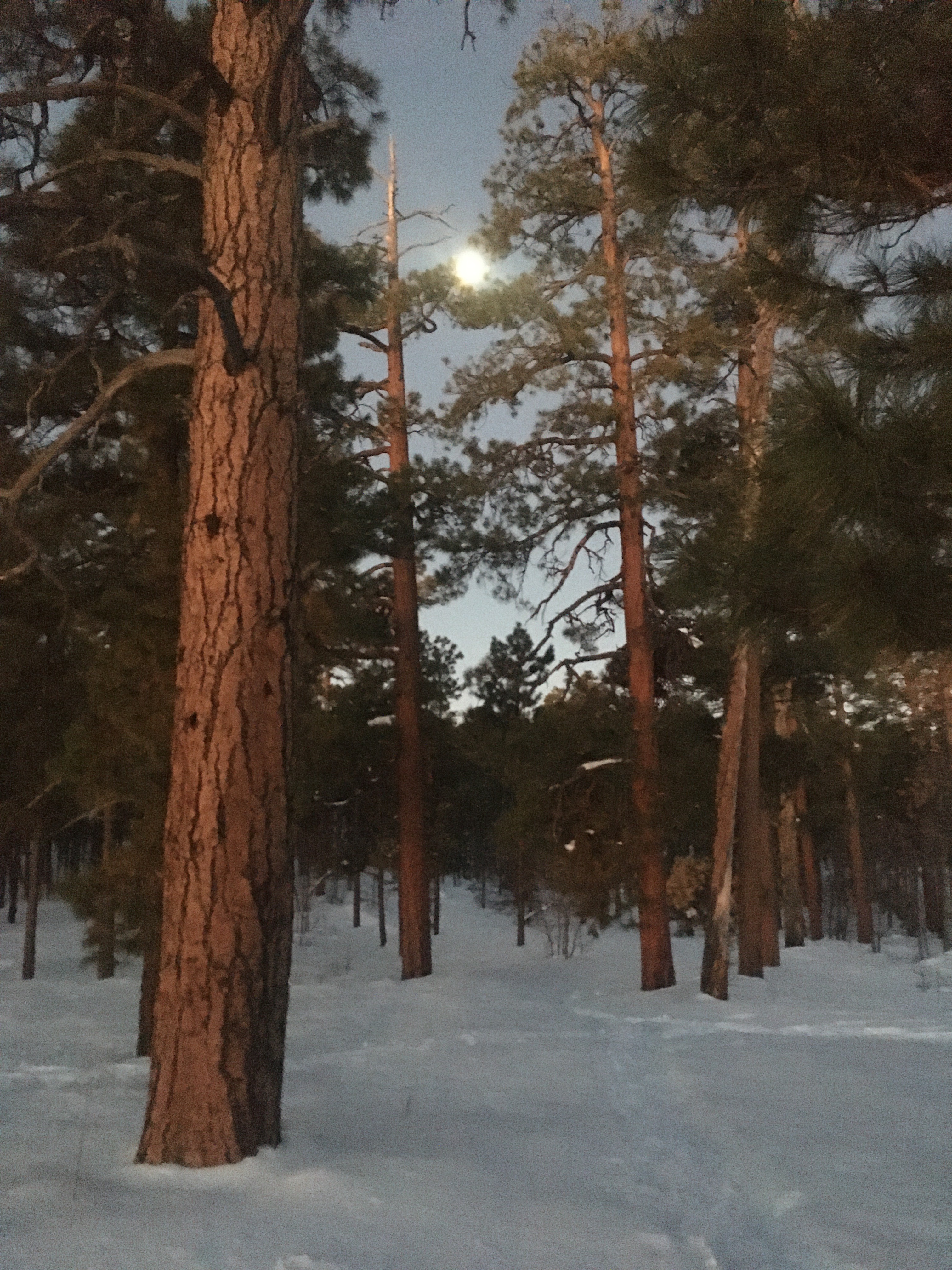
To my eyes, adapted as they’ve been to the artificial light of the kitchen, the night appears complete as I step out the back door. Complete, but not dark: the waning moon is still up, its cold light reflecting brilliantly off the snowbanks, setting the surface crystals to sparkling.
But the night is dying. By the time I’ve walked the two blocks to the park, crunching across the frozen slush of tire tracks, slipping where meltwater from curbside snowbanks has trickled downhill and refrozen into treacherous black ice, the eastern sky has changed. It’s not yet the pearly color of dawn but rather the deepest possible blue, a color of such can’t-look-away depth that it reminds me of the expensive saturated lapis of medieval paintings, a color that pointed toward Heaven. It’s right on the edge of what vision can perceive, a hue so deep that it points beyond itself to the spectrum of the wavelengths we cannot see, the ultraviolet and beyond. Maybe that’s just another way of saying what those medieval artists were trying to convey about God.
My path goes the other way, under the descending moon, where among the ponderosas night still prevails. Their trunks stand dark against the washed-out snow. The snow crunches under my snowshoes as I climb up the mesaside, quickly growing warm even though the temperature is well below freezing. Crossing the upper stretches of sled trails that will be teeming with visitors in a few hours, I enter the deeper woods undergrown with scraggly oak thickets.
By the time I near the mesa top, the sky above is distinctly lighter, and the eastern sky has warmed to an orange glow that seems to reflect the lights of the city below. The last rise is steep, but my snowshoes’ built-in crampons grip well enough, and soon I’m up on an open knoll that I’ve visited often in warmer seasons. From it there’s a good view of the cold-looking Peaks to the north, and of the far colder Moon tangled in pine branches to the west. In this wintry weather exploring either seems a real expedition, but I’ve often been up on those mountains before, and I know too that an Apollo astronaut who lived on the same street I’ve just come from walked way up there on the frozen Moon—a humbling thought.
A passing one, though, as I’m more fixated on the pines in which the Moon seems to have gotten caught. They’re tall old trees, the kind foresters call yellow pines because of their bark. In this dawn light they’re not yellow but gold, almost as if lit from within. If only David Douglas, the naturalist who came up with the name ponderosa for the species, had been out at dawn, on a snowy morning, in pellucid Southwest light—well, maybe we’d be referring to all of them as golden pines.
I’ve come up with a number of reasons over the years for why a Midwestern kid should have ended up in Arizona. As psychologists have pointed out, identifying rational reasons for such decisions is often an exercise in self-justification: we make a decision from the gut, then spend a great deal of emotional and intellectual energy in coming up with reasons for it that make sense to us—and that we can share with others. So here is my justification for today: it’s the light. It’s the light of Arizona’s sunrises and sunsets that lured me here, or that bade me stay: the deep blue of predawn when you are sleeping outside, the vast black of night far from city lights, the purple of a desert mountain range propped up flat against pale sky shortly after sunset.
It’s something I remembered again as I wound my way home, having taken a broad circular course across the mesa top. I descended a steep ravine, its boulders and fallen logs softened by snow and still passable for someone on snowshoes, then contoured across an east-facing slope studded with oaks. The sun had risen a half hour earlier. But the blue light of predawn was back, I saw to my wonder. Not in the sky, but on the ground, in the snowy shade of every tree. It was a cold color, one that I’ve only ever seen on snow when the sun is shining from a low angle, and it reminded me how relieved and grateful I was this past week when after many weeks of drought the winter storms came and dumped their generous loads of snow.
Beyond the shadows, the low sun tickled the surface of snow, kindling it into diamonds. I had a steep descent into the neighborhood in front of me. I had breakfast waiting at home, and the sounds of the daytime birds in the trees below. I took my time, listening to them, and didn’t hurry.

